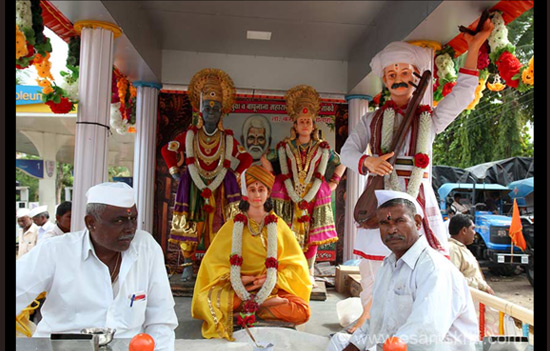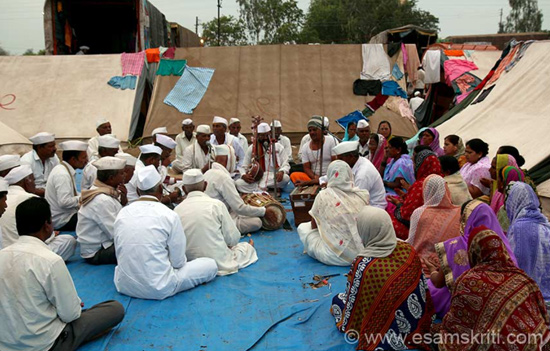- What
is an Abhang? How is it structured? Who were the pioneering Sants and their
legacy? Abhangs were translated into Bengali too-by whom!
Abhang is a form of devotional verse sung in praise of Lord Vitthal (also known as Vithoba, Panduranga, or Vishnu) of Pandharpur. These poetic compositions are chanted continuously by devotees during pilgrimages to Pandharpur, especially in the month of Ashadh (July–August).
The word abhang is derived from ‘a’ (non) and ‘bhang’ (breaking or interruption), meaning ‘unbroken’ or ‘continuous’—signifying uninterrupted devotional singing.
This article was first published in the Bhavan Journal.
While bhajans often reflect an inward spiritual journey, abhangs are more outward expressions of devotion. The Bhakti Sampradaya (Devotional Movement), initiated by Sant Dnyaneshwar and enriched by later saints such as Namdev, Eknath, Janabai, and Tukaram, promoted the idea that devotion to God did not require knowledge of Sanskrit or adherence to caste or creed. They believed that divine connection could be achieved by anyone through sincere devotion to Vitthal. This message deeply resonated with the masses, encouraging worship in languages other than Sanskrit— particularly Marathi—through poetry in the form of abhangs.
Abhangs blend folk storytelling with deep spiritual insight. Typically
composed of four lines and marked by rhythmic cadence, each abhang can stand
alone as a complete poem. However, they are often sung in succession to form a
narrative or thematic sequence.
Singing abhangs follows a distinct structure. It begins with naman—a salutation invoking the deity—followed by rupacha abhang, which describes the human form of God. It concludes with a moral or devotional message. The verses often recount episodes from the life of Lord Vitthal, who holds a special place in the hearts of the people of Maharashtra. These poems aimed to promote communal harmony and reject all forms of discrimination.
 Centre of pic is Sant Dynameshwar, right is Sant Tukram. Pandharpur 2015.
Centre of pic is Sant Dynameshwar, right is Sant Tukram. Pandharpur 2015.Pioneering Saints and their Legacy
Sant Dnyaneshwar, besides composing his magnum opus Jnaneshwari (a
commentary on the Bhagavad Gita), also wrote abhangs. He advocated Bhakti Marga
(the path of devotion) as essential for spiritual seekers and became a
prominent leader of the Varkari movement. His poems, collectively known as Abhangavani,
continue to inspire and transform lives with their spiritual potency.
Sant Namdev, who was slightly older than Dnyaneshwar and lived 50 years
longer, carried forward the mission of spreading devotion through abhangs.
Overflowing with divine love, his compositions encouraged chanting the name of God
as a path to immortality and spiritual bliss. His poems were heartfelt,
reflecting a profound relationship between the individual soul and the Supreme
Being, while also touching upon social realities of the time. During his life, Pandharpur
gained renewed religious significance.
Sant Eknath, another revered poet-saint, made a major contribution to spiritual literature by translating Jnaneshwari from Sanskrit into Marathi and composing a rich body of devotional works. His abhangs often emphasised repentance and humility. For instance, he wrote, “Unless we repent, God’s name will not come to our lips.
Repentance is the cause of ecstasy. If one repents sincerely, God will not be far from him.” His verses reflect a sense of union with the Divine and promote moral and spiritual living.
Sant Tukaram’s abhangs are deeply rooted in personal spiritual experience. His expression is frank, rustic, and often direct—yet filled with love and devotion. Tukaram wrote extensively about the struggles he faced on his path to God. His poetry conveys profound religious insight, lofty ideals, and practical wisdom, expressed in accessible language. One of his famous abhangs begins:
“God, you made me a Kumbi (potter), otherwise I would have died an arrogant hypocrite.”
This line subtly criticises caste-based discrimination.
 Varkaris
singing bhajans, kirtans enroute to Pandharpur. 2015.
Varkaris
singing bhajans, kirtans enroute to Pandharpur. 2015.
Tukaram’s abhangs remain integral to devotional gatherings today—no bhajan meet feels complete without them. His works are considered the high point of the Bhakti movement.
According to legend, Sant Namdev and Lord Vitthal appeared in his dream, telling him that his life’s mission was to write abhangs. He spent much of his life reflecting on and drawing inspiration from earlier saints like Dnyaneshwar, Namdev, and Eknath.
Abhangs in Translation
Tukaram’s spiritual legacy reached even beyond Maharashtra. Rabindranath Tagore, through his brother Satyendranath (an ICS officer posted in Maharashtra), was introduced to Tukaram’s poetry and translated some abhangs into Bengali.
The English translation of some of Tukaram’s abhangs is given below:
1. “I made an earthen image of Shiva,
But the earth is not Shiva;
My worship reaches Shiva,
The earth remains the earth it is...”
(Translated by Vasudev Kirtikar)
This abhang reminds us that devotion lies in the spirit, not in material
form.
2. “With head on hand before my door, I sit and wait in vain;
Along the road to Pandhari, My heart and eyes strain...”
(Nicol Macnicol, Psalms of Maratha Saints)
This expresses longing and the ache of separation from God.
3. “Holding my hand thou leadest me, my comrade everywhere;
As I go and lean on thee,
My burden thou dost bear...”
(Nicol Macnicol)
This poem reflects joyful surrender and divine companionship.
4. “Oh God, let me be small like the ant That gets sugar particles sweet.
Great elephant Airavat is heavenly,
But must bear the painful iron hook...”
(Translated by Kishor Kulkarni)
Here, Tukaram extols the virtue of humility over the burden of greatness.
Centuries later, abhangs remain widely sung and revered. Eminent musicians like Bhimsen Joshi, Kishori Amonkar, Sudhir Phadke, Suresh Wadkar, and Aruna Sairam have performed them. Today, there are numerous groups—including many non-Maharashtrians—dedicated to singing abhangs and teaching them through workshops and classes.
This article was first published in the Bhavan’s Journal, July 16-31, 2025 issue. This article is courtesy and copyright Bhavan’s Journal, Bharatiya Vidya Bhavan, Mumbai-400007. eSamskriti has obtained permission from Bhavan’s Journal to share. Do subscribe to the Bhavan’s Journal – it is very good.
Also read
1.
Pandharpur
Wari album
2.
Vithoba
of Pandharpur
3.
Varkari
Movement
4.
Sant
Dyaneshwar, pioneer of the Bhakti Movement
5.
Eknath,
the Reformer
6. Pandharpur Wari is Spiritual Democracy